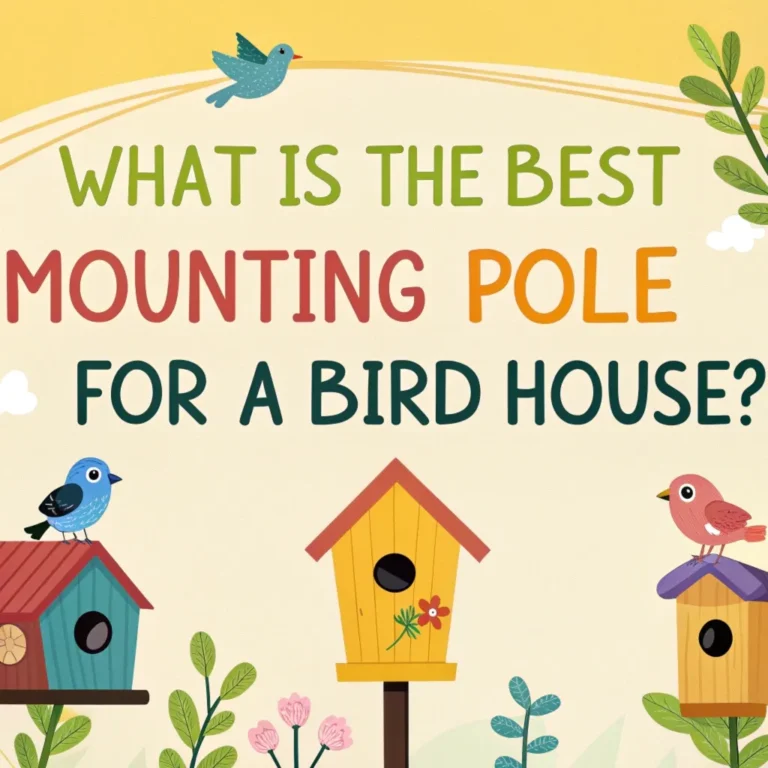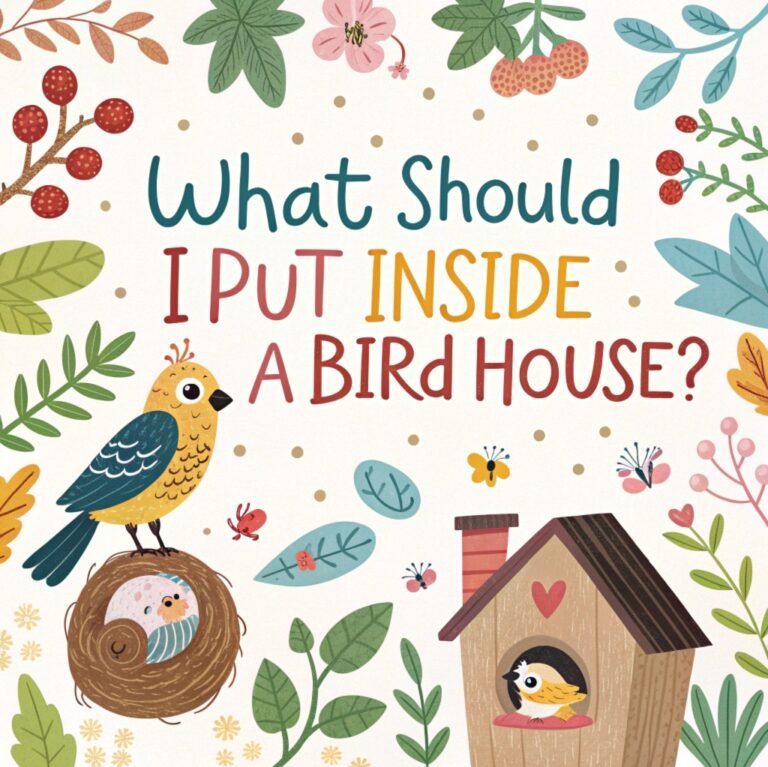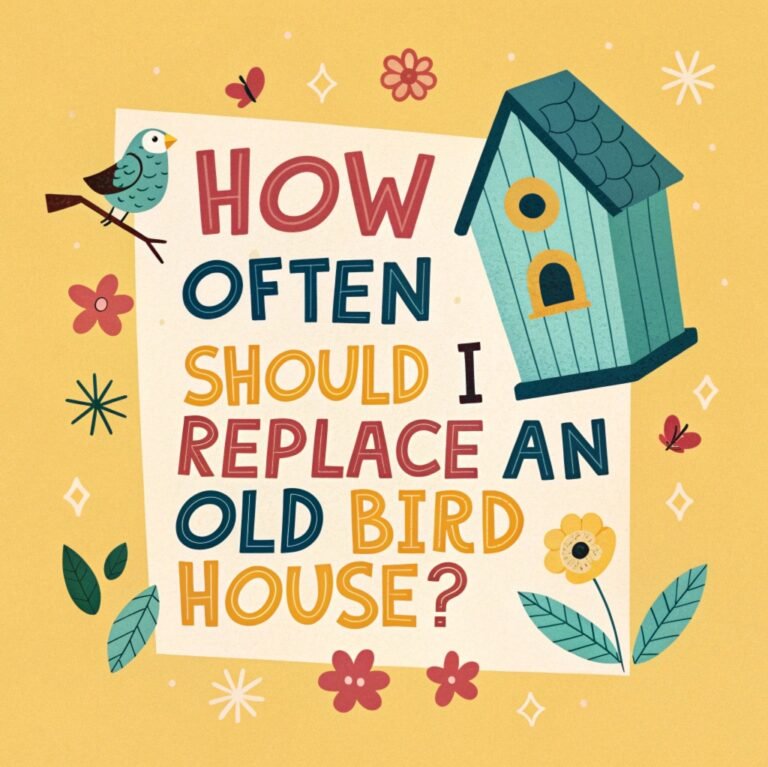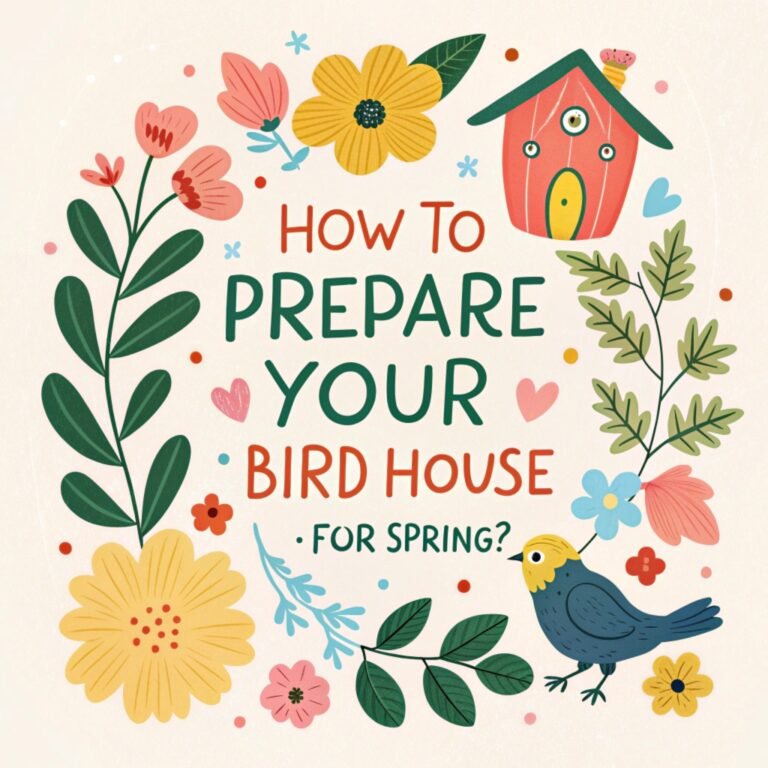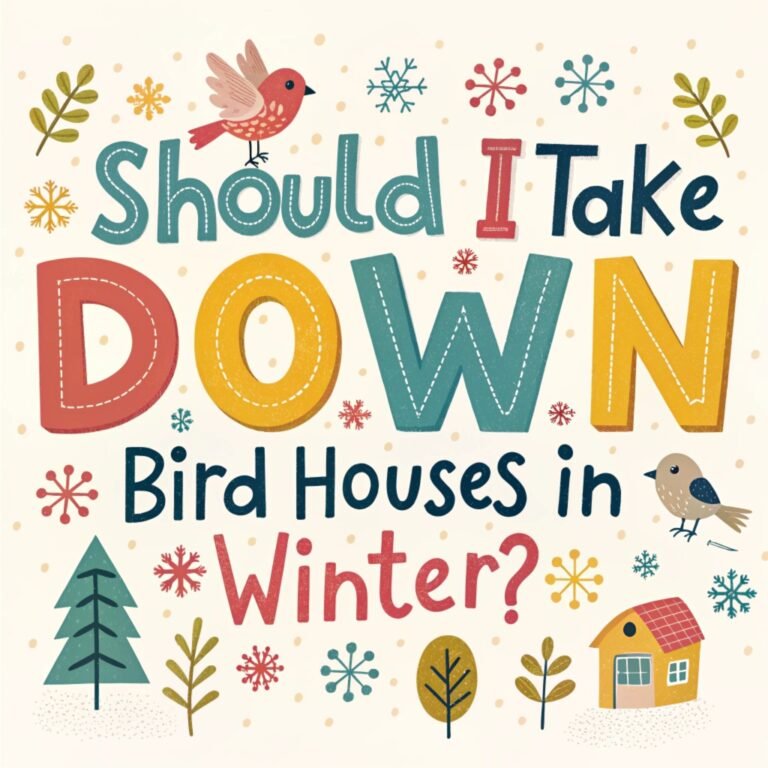How To Winterize a Bird House? – Essential Tips for Creating a Cozy and Safe Shelter During the Cold Months
Winter is a challenging time for our feathered friends, and providing them with a safe and warm shelter can make all the difference.
A well-prepared bird house not only offers protection from the harsh elements but also ensures that birds have a cozy place to rest and thrive.
In this guide, we will explore essential tips and practical steps to winterize your bird house, making it a haven for birds during the cold months.
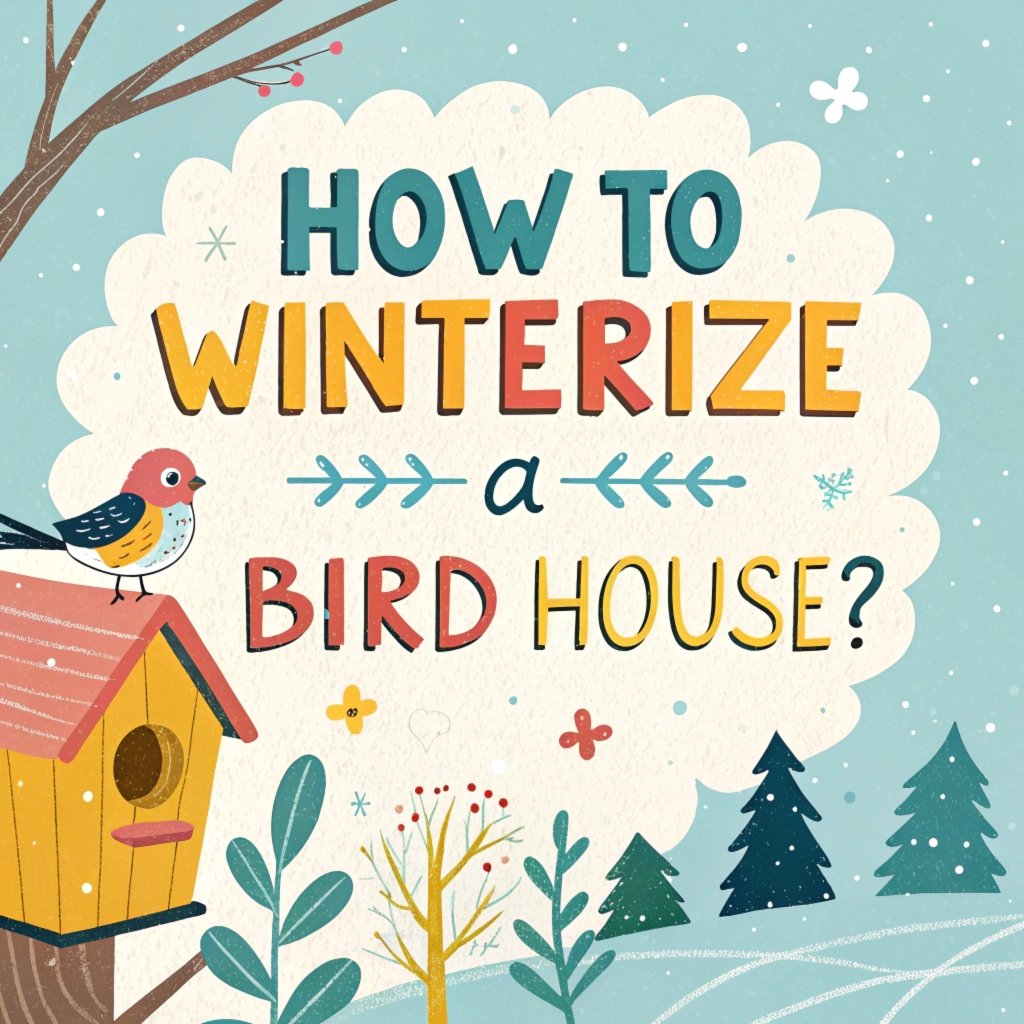
Key Takeaways
- Winterizing a bird house helps birds survive harsh weather by providing a warm and safe shelter.
- Cleaning the bird house thoroughly removes old nesting materials and prevents diseases.
- Adding insulation like wood shavings or dried grass keeps the interior warm.
- Ensuring proper ventilation prevents moisture buildup and keeps the bird house dry.
- Positioning the bird house in a sheltered location protects it from wind and predators.
- Regular maintenance throughout winter ensures the bird house remains a safe haven.
- Avoid common mistakes like using toxic materials or neglecting predator-proofing measures.
- Winterizing supports the overall health and survival of local bird populations.
- DIY methods can make winterizing affordable and accessible for everyone.
- Attracting birds to your winterized bird house can be achieved with proper placement and food sources.
- Understanding the needs of birds in winter helps create a more effective shelter.
Why Winterizing Your Bird House is Important
Winterizing your bird house is not just about keeping it clean; it’s about ensuring that birds have a safe and comfortable place to rest during the cold months.
Birds face numerous challenges in winter, from freezing temperatures to predators. By preparing their shelters, you can help them survive and thrive.
A well-maintained bird house can also attract more birds to your garden, creating a lively and vibrant environment. Cavity-nesting birds, including many songbirds, use bird houses in the colder months.
Bluebirds, chickadees, titmice, screech owls, swallows, cardinals, sparrows, jays, wrens, and woodpeckers will all use bird houses or roost boxes to stay warm and out of inclement weather during winter.
Especially for smaller birds, finding a safe, warm, and dry place to rest is critical during harsh winter weather.
Your bird house also acts as protection against hungry predators preying on birds that are weak and vulnerable from fighting freezing temperatures.
Understanding the Needs of Birds in Winter
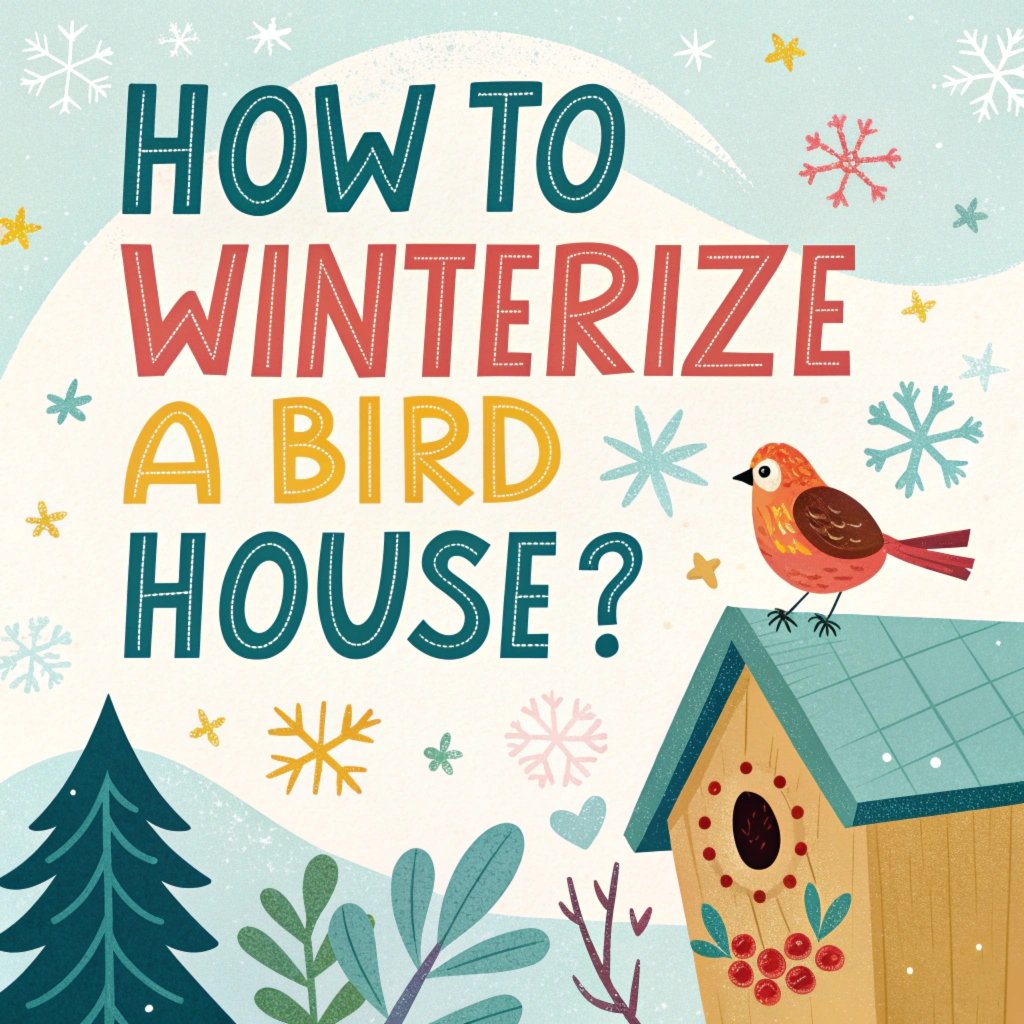
Birds have unique needs during winter. They require a warm and dry place to rest, away from the harsh elements. Understanding these needs is crucial for effective winterizing.
Birds like chickadees, bluebirds, and woodpeckers often seek shelter in bird houses. Providing them with a well-prepared space can make a significant difference in their survival.
During winter, birds need to conserve energy and stay warm. They often huddle together in small spaces to share body heat and protect themselves from the cold.
A properly winterized bird house provides this essential shelter. It’s important to note that birds also need fresh water and food sources during winter.
While the bird house offers protection, complementing it with nearby feeders and a heated birdbath can create a complete winter haven for your feathered visitors.
By understanding and meeting these needs, you can significantly increase the chances of birds surviving the harsh winter months.
Choosing the Right Materials for Insulation
Choosing the right materials is essential for insulation. Use natural materials like wood shavings, dried grass, or hay to keep the bird house warm. Avoid using toxic substances or materials that can retain moisture.
A well-insulated bird house ensures that birds stay comfortable and safe throughout the winter. When selecting insulation materials, opt for those that mimic natural nesting materials.
Pine shavings, clean and dried grass, hay, dry wool, and wood shavings are all excellent choices. These materials provide warmth while allowing for proper air circulation.
It’s crucial to avoid synthetic materials or those treated with chemicals, as these can be harmful to birds.
The insulation should be loose enough to allow birds to burrow into it, creating a cozy nest-like environment.
Remember to replace the insulation regularly throughout the winter to keep it clean and dry.
By choosing the right insulation materials, you’re creating a warm sanctuary that closely resembles the natural cavities birds would seek in the wild.
Cleaning and Preparing the Bird House
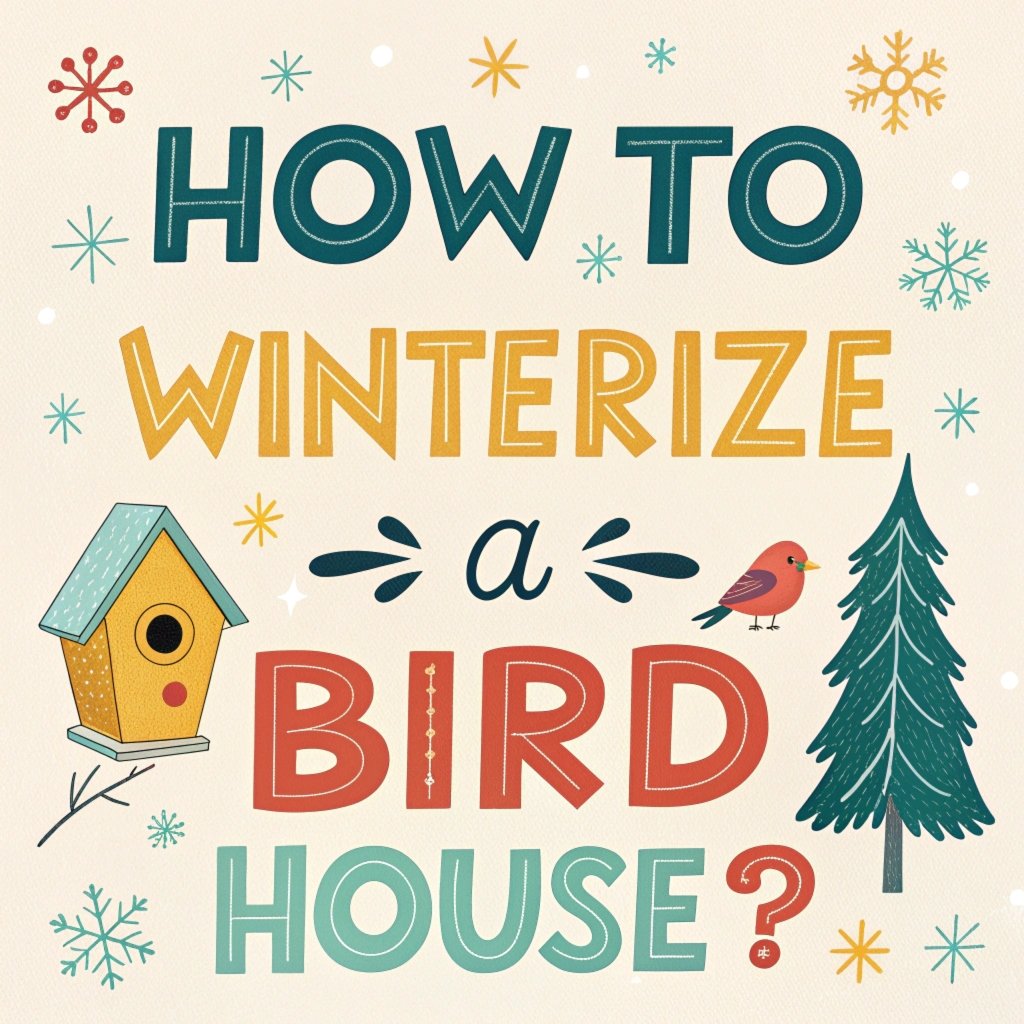
Cleaning the bird house is the first step in winterizing. Remove old nesting materials and debris to prevent diseases. Use a mild soap solution to clean the interior and let it dry completely before adding insulation.
A clean bird house is a healthy and inviting space for birds. Start by taking down the bird house and inspecting it thoroughly.
Look for any signs of damage, such as cracks or loose boards, and repair them as needed. Remove all old nesting materials, as these can harbor parasites and diseases.
Scrub the interior with a solution of one part bleach to nine parts water to disinfect it. Rinse thoroughly and allow the bird house to dry completely in the sun.
This cleaning process not only prepares the house for winter but also helps prevent the spread of avian diseases.
Once clean and dry, you can begin the winterizing process. Remember to wear gloves during cleaning and be cautious of any wasps or other insects that may have taken up residence in the bird house.
Adding Insulation for Warmth
Adding insulation is a critical step. Line the interior with wood shavings or dried grass to retain heat. Ensure that the insulation is evenly spread and does not block the entrance.
This simple step can make the bird house significantly warmer and more comfortable for its inhabitants.
When adding insulation, create a layer about 2-3 inches thick at the bottom of the bird house. This provides a soft base for birds to rest on and helps trap warm air.
Be careful not to overfill the house, as birds need space to move around and perch. For woodpeckers, waterfowl, and owls, consider adding a layer of dry sawdust or wood chips, as these species prefer such nesting materials.
If you’re using a roost box, which is designed specifically for winter use, you can add more insulation, as these boxes are typically larger and can accommodate more birds huddling together.
Remember to check and replace the insulation periodically throughout the winter to ensure it remains dry and clean.
Ensuring Proper Ventilation
Proper ventilation is essential to prevent moisture buildup. Drill small holes near the top of the bird house to allow air circulation. This helps keep the interior dry and reduces the risk of mold or mildew, ensuring a healthy environment for birds.
While it might seem counterintuitive to add ventilation when trying to keep the bird house warm, it’s crucial for maintaining a healthy environment.
Moisture from birds’ breath and droppings can accumulate, leading to dampness and potentially harmful mold growth.
To create proper ventilation, drill several 1/4-inch holes just below the roof line on each side of the bird house.
These holes allow for air flow without creating drafts. In addition to ventilation holes, ensure that the entrance hole is the appropriate size for the species you’re targeting.
This helps prevent larger predators from entering while still allowing for some air exchange.
Remember, the goal is to create a balance between warmth and fresh air, mimicking the conditions birds would find in natural tree cavities.
Protecting the Bird House from Predators
Protecting the bird house from predators is crucial. Install predator guards around the entrance to keep out unwanted visitors.
Position the bird house in a location that is difficult for predators to access, such as on a pole or high tree branch.
Predator guards can be simple metal plates that surround the entrance hole, making it difficult for larger birds or mammals to reach inside.
Another effective method is to use a baffle, which is a dome-shaped device that can be installed below the bird house on its supporting pole.
This prevents climbing predators from reaching the house. When positioning the bird house, consider placing it at least 10 feet off the ground and away from branches or structures that predators could use to access it.
If mounting on a tree, use a predator guard on the trunk below the house. It’s also important to ensure that the entrance hole is not too large, as this can allow predators to enter.
By taking these precautions, you’re providing birds with a safe haven where they can rest without fear of predation.
Positioning the Bird House for Maximum Comfort
The placement of the bird house can impact its effectiveness. Choose a sheltered location that is protected from strong winds and direct sunlight.
Position the entrance away from prevailing winds to keep the interior warm and comfortable. Ideally, the bird house should face south or southeast to capture the morning sun and provide warmth throughout the day.
This orientation also helps protect against cold north winds. If possible, place the bird house near natural windbreaks such as dense shrubs or evergreen trees.
These can provide additional shelter and protection from harsh weather. Consider the height at which you place the bird house.
Different species prefer different heights, but generally, a height of 5 to 12 feet off the ground is suitable for most small birds.
Ensure that the bird house is securely mounted and doesn’t sway in the wind, as this can deter birds from using it.
By carefully considering the position of your bird house, you can create an inviting winter retreat that birds will be eager to use.
Maintaining the Bird House Throughout Winter
Regular maintenance is key to ensuring the bird house remains a safe haven. Check for damages, clean the interior, and replace insulation as needed. Consistent care can extend the life of the bird house and keep it inviting for birds.
Throughout the winter, make it a habit to inspect your bird house regularly. After storms or severe weather, check for any damage or leaks and repair them promptly.
Remove any snow or ice that may accumulate on the roof or around the entrance hole, as this can block access or cause dampness inside.
If you notice that the insulation has become wet or compacted, replace it with fresh, dry material. It’s also important to periodically clean out any droppings or debris that may accumulate inside the bird house.
This helps prevent the spread of diseases and keeps the environment healthy for its occupants.
If you notice that birds aren’t using the house, consider adjusting its position or adding more insulation.
By maintaining your bird house throughout the winter, you ensure that it remains a welcoming and safe space for birds seeking shelter from the cold.
Common Mistakes to Avoid When Winterizing
Avoid common mistakes like using toxic paints or neglecting ventilation. These errors can make the bird house less effective and even harmful to birds. Follow best practices to create a safe and welcoming shelter.
One common mistake is using treated wood or toxic paints, which can be harmful to birds. Always use untreated wood and, if painting, choose non-toxic, water-based paints in natural colors.
Another error is making the bird house too airtight in an attempt to keep it warm. This can lead to poor ventilation and moisture buildup, which can be detrimental to birds’ health.
Avoid using materials that retain moisture, such as cloth or felt, as these can become breeding grounds for mold and bacteria.
Some people make the mistake of adding perches to the exterior of the bird house, which can actually make it easier for predators to access the entrance. Instead, ensure the interior has rough surfaces or small perches for birds to grip.
Lastly, don’t forget to remove any summer modifications, such as sun shields or additional ventilation holes, that might make the house too cold in winter.
Benefits of Winterizing for Bird Populations
Winterizing your bird house benefits not just individual birds but entire populations. By providing a safe shelter, you support the survival and health of local bird species, contributing to biodiversity and ecological balance.
When birds have access to safe, warm shelters during winter, their chances of survival increase significantly.
This is particularly important for species that don’t migrate and must endure harsh winter conditions. By offering a reliable winter refuge, you’re helping to maintain healthy bird populations in your area.
These birds, in turn, play crucial roles in the ecosystem, such as controlling insect populations and dispersing seeds.
Winterized bird houses can also provide valuable data for bird watchers and researchers, offering insights into winter bird behavior and population trends.
Moreover, by supporting bird populations through the winter, you’re ensuring a vibrant and diverse bird community in your garden come spring.
This not only enhances the natural beauty of your surroundings but also contributes to the overall health of the local ecosystem.
How to Attract Birds to Your Winterized Bird House
Attracting birds to your winterized bird house involves more than just preparation. Provide food sources like seeds and suet nearby to encourage birds to visit.
A well-placed and maintained bird house can become a hub of activity in your garden. Start by placing bird feeders near your winterized bird house.
Offer a variety of foods such as black oil sunflower seeds, suet cakes, and nyjer seeds to attract different species.
Remember to keep feeders clean and regularly stocked throughout the winter. Providing a source of fresh water is equally important.
A heated birdbath can be a major attraction for birds during freezing temperatures. Position the bird house and feeders near natural shelter like evergreen trees or dense shrubs, which provide additional protection and make birds feel more secure.
Consider creating a brush pile nearby, which can offer extra shelter and foraging opportunities. Lastly, be patient.
It may take time for birds to discover and trust your new winter setup. Consistency in maintaining the bird house, feeders, and water source will eventually pay off, turning your garden into a winter haven for a variety of bird species.
DIY Tips for Winterizing on a Budget
Winterizing doesn’t have to be expensive. Use DIY methods like repurposing materials for insulation or building your own bird house. These cost-effective solutions can make winterizing accessible to everyone.
One budget-friendly option is to repurpose materials you already have. Old blankets or towels can be cut up and used as insulation, as long as they’re natural fibers and free from chemicals.
Dried leaves, straw, or even clean dryer lint can serve as effective insulation materials. If you’re handy, consider building your own bird house using scrap wood or recycled materials.
There are many free plans available online for simple bird house designs. For predator guards, repurpose items like old pie tins or plastic containers.
Create a DIY heated birdbath by placing a submersible aquarium heater in a regular birdbath. Instead of buying expensive commercial bird food, make your own suet cakes using kitchen scraps and seeds.
Remember, the most important aspect is providing a safe, warm shelter – it doesn’t need to be fancy or expensive to be effective.
Frequently Asked Questions
Q: How often should I clean the bird house during winter?
A: Clean the bird house at least once a month to remove debris and check for damages.
Q: Can I use synthetic materials for insulation?
A: It’s best to use natural materials like wood shavings or dried grass to ensure safety and comfort for birds.
Q: What should I do if predators are targeting the bird house?
A: Install predator guards and reposition the bird house to a safer location.
Q: Is it necessary to provide food near the winterized bird house?
A: While not strictly necessary, providing food nearby can attract more birds and help them survive the winter.
Q: Can I use the same bird house for winter that was used in summer?
A: Yes, but make sure to clean it thoroughly and modify it for winter use by adding insulation and sealing unnecessary ventilation holes.
Q: How can I tell if birds are using my winterized bird house?
A: Look for signs like droppings near the entrance, worn areas around the hole, or glimpses of birds entering or leaving the house.
Q: Should I remove snow from the bird house?
A: Yes, gently remove snow from the roof and entrance to ensure birds can access the house and prevent moisture buildup inside.

Hello, I’m Amelia White, the founder of birdsfanatic.com. As a lifelong bird enthusiast and spiritual seeker, I’ve always been fascinated by the mystical connections between birds and the human experience. On this site, I share my knowledge and insights into the symbolic meanings and spiritual significance of various bird species, exploring their roles in mythology, folklore, and cultural traditions. Join me on this journey into the world of birds, where we’ll discover the hidden wisdom and guidance that these magnificent creatures have to offer.


